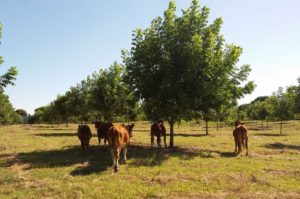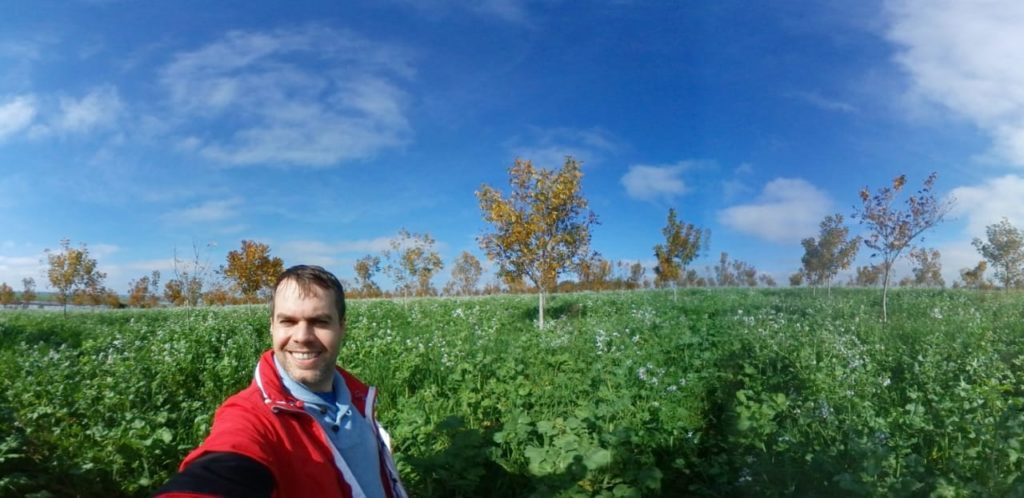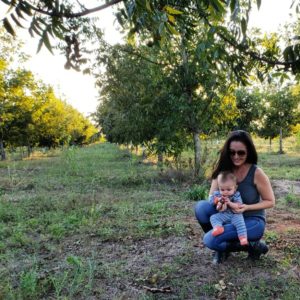Brazil aims to be among the top pecan producers in the next 20 years
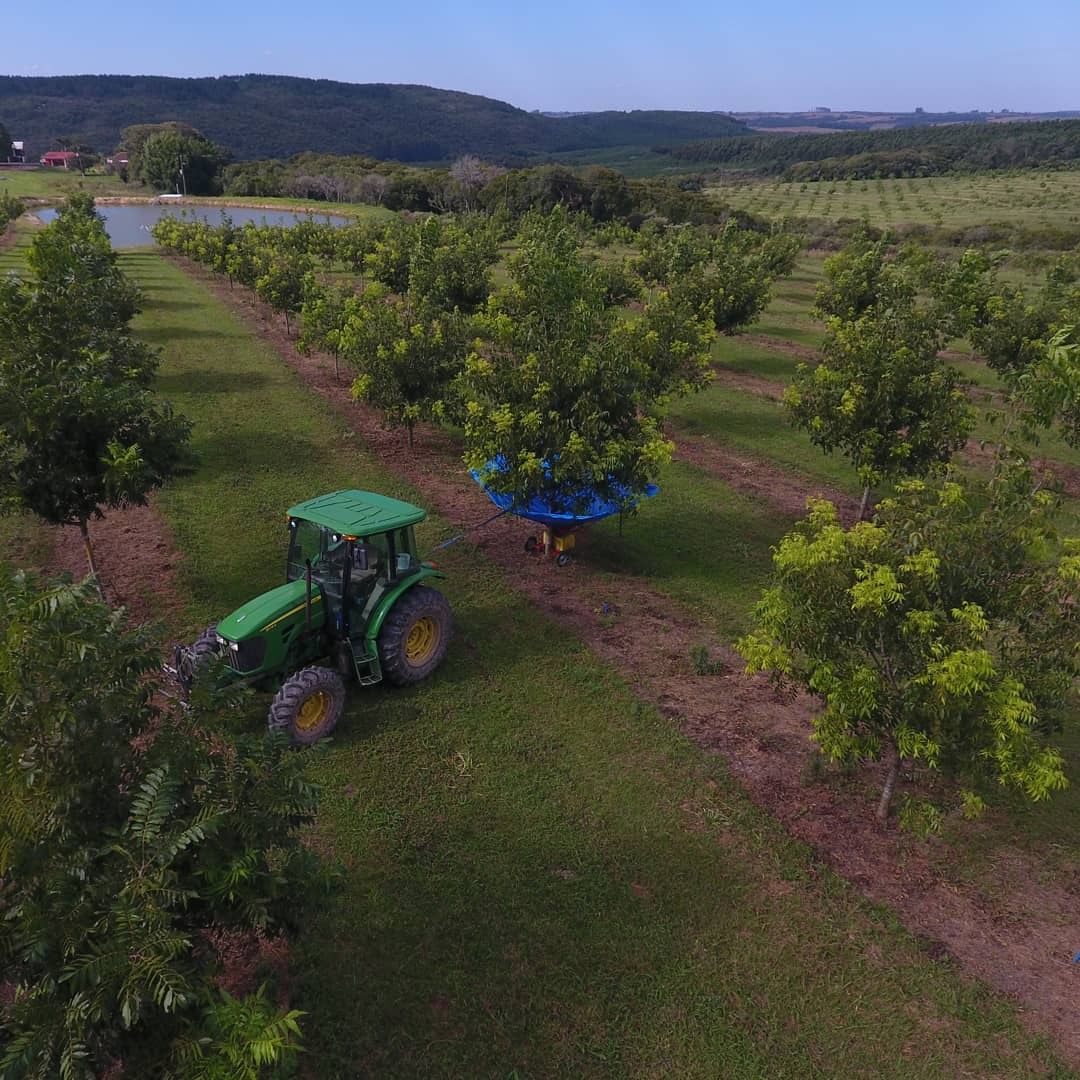
Pecan grove Pecanera Brasil in Encruzilhada do Sul, Rio Grande do Sul, Brazil. (Photo courtesy of Nadia Venticinque)
Yet, it was not until 1915 when three cultivars from the United States were planted with commercial purpose on a farm in the mountainous region of Rio de Janeiro. The Agronomic Institute of Campinas (IAC) also imported commercial cultivars, and, later in 1929, the Dierberger Nursery (Citra Farm) in Limeira, São Paulo, began importing pecan varieties. The Dierberger Nursery was the first nursery to grow pecan seeds from commercial cultivars imported from the United States.
Although pecan was initially introduced in the southeastern region of Brazil, the crop did not develop on a large scale in this region. Instead, it was the municipality of Anta Gorda in Rio Grande do Sul that pioneered pecan cultivation—or “pecaniculture”—in Brazil.
Back in 1945 Anta Gorda’s first mayor, Mr. Arminho Miotto, a visionary who was always looking for agricultural alternatives to develop the region, came across a brochure from the Dierberger Nursery offering seedlings of pecan stems (grafted rootstocks) from Kentucky, U.S. Miotto soon thought of new possibilities and, that same year, he bought four pecan trees, which still exist in the municipality and are the ancestors of many orchards in southern Brazil.
In the 1960s, a rapid expansion of pecan cultivation occurred in southern Brazil due to tax incentives. At this time, thousands of orchards were planted, but without the necessary management techniques, these orchards did not reach the productivity needed to justify their maintenance. For many years, pecan production remained active mainly in small rural properties for their own consumption or local commerce.
Pecan production began to gain strength in 2000 because of the higher prices paid for the nut and the guarantee of commercialization by the growing Brazilian pecan industry. Since then, the production chain has been in constant development. Research focused on the Brazilian reality, the selection of adapted cultivars, the production of quality grafted rootstocks, the implementation of properly handled orchards, the development of new equipment for harvesting and processing nuts, the opening of new markets, as well as the creation of the Brazilian Pecaniculture Institute (IBPecan), are factors that are contributing to the development of Brazilian pecaniculture.
Founded in October 2018, IBPecan is a non-profit association, consisting of producers, technicians, and companies dedicated to the cultivation, production, and industrialization of pecan, that aims to guide, promote, and stimulate the production, marketing, and distribution of pecan through events, courses, and partnerships with public and private institutions. IBPecan works to develop the Brazilian pecan nut production chain by directing its activities in three axes: quality, productivity, and value. The first axis—quality—entails developing quality throughout the supply chain from seedling production to fruit harvesting and selection. The second seeks to increase productivity by stimulating Brazilian research and disseminating good management practices. And lastly, IBPecan aims to generate value by promoting consumption, adding value to primary production, and seeking new markets for the Brazilian pecan.
The steady development of the Brazilian pecan sector is in a big part due to the coordinated work that IBPecan does with federal institutions like the Brazilian Agricultural Research Corporation of the Ministry of Agriculture, Livestock and Food Supply (EMBRAPA), the Federal University of Pampa (UNIPAMPA), and partnerships with the Federation of Industries of the State of Rio Grande do Sul (FIERGS), and the National Rural Learning Service (SENAR).
“Most recently, IBPecan made cooperation agreements with EMBRAPA and UNIPAMPA, which have ongoing programs to identify the cultivars we have in Brazil and characterize new genetic materials, agroforestry conduction of pecan, diagnosis and management of diseases, evaluation of matrices for rootstocks, evaluation of fungi for biological control of diseases, and quantification of carbon sequestration by pecan orchards,” explained Demian Segatto da Costa, president of IBPecan, the Brazilian Pecaniculture Institute.
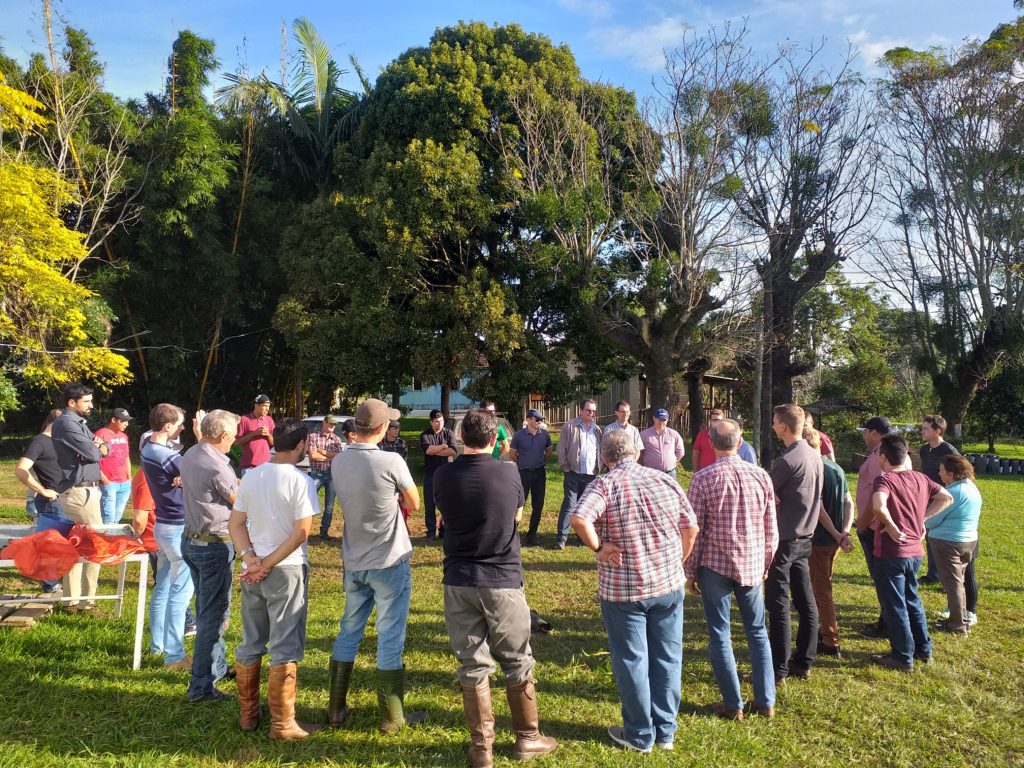
Training about pecan production organized by IBPecan in 2019 in Santa Maria, Rio Grande do Sul, Brazil.
The sector involves more than 1,850 growers who account for 24,710.5 planted acres (2.47 acres is 1 hectare) distributed mainly in the states of Rio Grande do Sul (70%), Santa Catarina (22%), and Parana (8%). A recent edaphoclimatic survey done by EMBRAPA detected 5,204,780.6 acres in Parana, 9,023,668.2 acres in Santa Catarina, and 28,002,498.3 acres in Rio Grande do Sul suitable for pecan production. In these areas, pecan cultivation competes with traditional crops such as soybeans, corn, and livestock. This finding shows how huge the potential for pecan production is in Brazil.
Orchards are mostly small, between 1.2 to 12 acres, with a significant increase of orchards from 24.7 to 123.6 acres. There are some medium-sized orchards between 24.7 to 270.7 acres located mainly in Rio Grande do Sul, where the largest orchard in the country is also located with 1,668 acres.
In 2021, 12,355.2 acres were harvested with an estimated productivity of 1,000 pounds per acre, which set a new record of 10 million pounds of production. The 2020/21 crop surpassed the historical mark of the 2018/19 crop, when 8 million pounds were harvested. And how was this possible? Because growers are constantly seeking improvements throughout the production chain, as well as increasingly implementing good agricultural practices.
“IBPecan Institute is committed to monitoring this whole process and guiding the producer to meet sanitary and commercial requirements of domestic and international markets. Every production cycle needs to be carried out with dedication, responsibility, using good management practices, aiming at the environmental and financial sustainability of the entire system and the sectors involved,” said Segatto da Costa. “The quality of the fruit is what interests us the most and, therefore, care should start from the field, with a good choice of the place for the implantation of the orchard.”
In this sense, productive areas were not randomly defined. In 2020, EMBRAPA conducted edaphoclimatic zoning of pecan nut for the southern region of Brazil where most orchards are located, which helps growers choose the micro-regions by soil and climate best suited for pecan. After defining the site, the choice of grafted rootstocks and cultivars adapted to the region is the next step. Pecan trees that originate from nurseries registered in the Ministry of Agriculture, Livestock and Food Supply must be allied to the better management of fertility, sanity, and irrigation of the orchard, all essential for obtaining good size and quality nuts. The most popular varieties in Brazil are ‘Barton,’ ‘Desirable,’ ‘Jackson,’ and ‘Success.’
Although Brazil experiences wide periods of rainfall during the reproductive phase of the crop, producers use irrigation and fertigation to seek standardized and stable production, as well as supply localized deficiencies that vary year after year.
During harvest, care is observed regarding the preparation of the orchard, organization of equipment, and training of employees so that all tasks are carried out efficiently. Growers and their teams work to collect the highest quality nuts and then subsequently dry these fruits until they reach the appropriate humidity level for commercialization.
In small orchards, growers predominately use sticks (taquaras) to knock nuts out of trees, while in medium-sized orchards shakers with belts and three-point hitches are used. Inverted umbrellas are not very common and are only used in orchards with high density, in which trees tend to be smaller. Most growers manually collect pecans with canvases.
The small and medium-sized equipment industry continues to grow as new orchards enter production and demand increases. Equipment such as hand pickers (wire globe), strap and three-point vibrators (shakers), peelers to shell the nuts, air pickers/sieves, and others of different models and capacities are being developed.
Traditionally, producers have small cleaning and drying facilities. There are no plants providing cleaning, drying, sorting and storage services. This type of facility exists in the processing industries. Large commercial processors are expanding their operational capacity by importing specific machines with higher operating performance. Currently, there are few complete processing plants in Brazil with cleaning, drying, sorting (bitolagem), and cold storage units for pecans. Many producers sell their shelled production in local shops, and many small family agro-industries with smaller scale peelers are emerging. Among the large active processors, the installed processing capacity is estimated to be close to 7.6 million pounds per year.
Established processors are making major investments in the expansion and modernization of their facilities and in their employees’ training. This should result in doubling the actual processing capacity in the next 3 to 5 years.
Because it is a fruit cultivated in southern Brazil, most of the country does not yet know about pecan and its qualities, so the potential for consumption growth is considerable. Brazilians’ appreciation of healthy eating habits and plant-based food puts pecan in a favorable position to increase its consumption in the domestic market, where wholesale, retail, and food service lead in nut sales.
The challenge remains to show consumers its nutritious content, positioning pecan as a healthy product with “Superfood” benefits. These promotions are being carried out by the processing industry itself and entities in the nut sector, mainly using digital channels. A significant increase in sales has been identified since the beginning of the COVID-19 pandemic from virtual stores to direct-to-consumer sales, especially to the public focused on healthy eating.
“It is in the retail sector that we see different pecan-based products, from nut bars to ice cream, with good openness to brands with a healthy appeal. On the wholesale side, the pecans are primarily peeled in various sizes and packages,” Segatto da Costa explained.
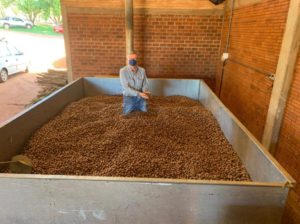
Carlos Eduardo Scheibe, Former President of IBPecan and current Public Relations, posing with his inshell pecans.
But Brazilian pecans are also exported. International shipments started in mid-2000 to Asia when production was still low. With the entry into production of orchards planted in the last decade, the sector will have enough pecans to serve international demand. This will be possible not only because of the increasing volume, but also because most of these new orchards have been developed at a high technological level, focusing especially on complying with international market standards, making Brazil a viable alternative for pecan supply. This season, the first volumes of these inshell pecans are being exported.
With more than 2,471.1 acres planted each year with increasing technological capabilities, IBPecan estimated that by 2030 planted pecan trees will cover an area of 61,776 acres, of which 37,065.8 acres will already be in production resulting in 50 million pounds per year. Two-thirds of that volume will be exported; meanwhile, the Brazilian Ministry of Agriculture, Livestock and Food Supply is negotiating access to new markets, such as China.
“Brazil is recognized for its agricultural potential. We have fertile soils and favorable climate, growers with investment capacity and available productive areas, competent research institutions, universities with agronomic training capacity, and government support at the department, State, and Federal levels, all of which certainly enables us to be among the main pecan producers in the next 20 years,” said Segatto da Costa.

